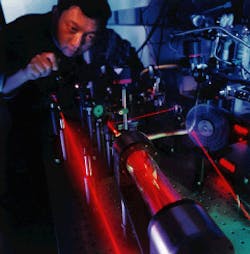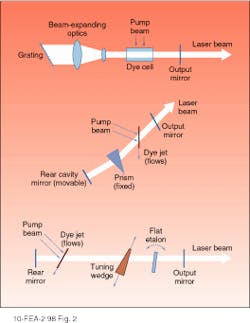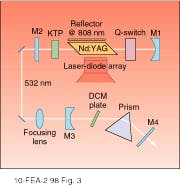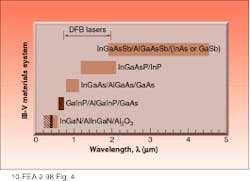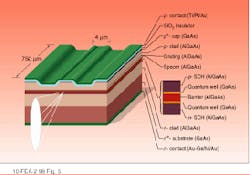The ability to tune a laser continuously across a range of wavelengths is important in a number of fields. While tunable dye lasers based on liquid lasing mediums have long existed, the drive is now on to perfect a range of far-more-compact, simple, and convenient solid-state lasers that eventually can cover the same wide wavelength band. Indeed, at least in the laboratory, tunable lasers cover most of the spectrum from ultraviolet (UV) to far-infrared (IR), although in many cases commercial devices are not yet available.
There are currently four broad application areas for which tunability is essential. Laser spectroscopy requires tuning to scan across a wavelength range for applications such as pollution detection, environmental monitoring, and other forms of remote sensing from aircraft or satellites. With the development of communications technology, wavelength-division multiplexing requires tunable lasers to precisely select an array of wavelengths, each carrying a separate signal on a common fiber. In medicine, tuning to narrow frequencies is often required to focus laser energy onto given targets. Finally, tunable lasers that can produce a broad range of wavelengths are essential for ultrafast pulses.
Fundamentally, the shorter the pulse, the broader the wavelength range contained in it, so the broader the range of the laser. Such ultrafast-pulse lasers will be the subject of a future Back to Basics article.
Short-wavelength tuners
There are several types of tunable lasers, because many basic laser designs can be modified to produce tunability. Organic-dye, vibronic, excimer, carbon dioxide, diode, and free-electron lasers (FELs) can all be made to vary their wavelengths within a broad or narrow range. In addition, nonlasers, such as optical parametric oscillators (OPOs), can be linked to pump lasers to produce tunability.
At the shortest wavelengths in the far-UV, excimer lasers, using noble gases, are the only simple source for tunable lasers, although frequency-doubling and tripling can produce tuned extreme-UV radiation from longer-wavelength lasers. To produce a tunable broad-wavelength output, mixtures of argon and krypton can be used, with the mixture allowed to expand through a supersonic nozzle into a vacuum. In the process, energy is transferred between the two species, and continuous radiation is generated covering most of the range from 120 to 190 nm. Specific wavelengths can then be selected by using an optical cavity with an adjustable length.
In the broad band between 300 and 1100 nm, organic-dye lasers have long been the dominant form of tunable laser. These lasers use organic dyes in a liquid solution. The dyes have a wide range of vibrational states, and transitions can occur over a nearly continuous span of wavelengths. Individual dyes can cover a significant span of wavelengths, but to cover the entire visible spectrum, different classes of molecules must be used. Thus, oxadiazoles, oligophenylenes, and stilbenes cover the blue end of the spectrum, coumarins, and xanthenes cover the greens and yellows, and merocyanine and cyanines cover the red to IR end of the spectrum (see Fig. 1).Organic dyes are fragile and degrade after tens or hundreds of hours of use, in contrast to most other laser media. They are not soluble in water, so methanol, ethanol, and other solvents are normally used. The dye solution is either contained in a sealed cell or is pumped rapidly through a cell to limit heating and dye degradation. In continuous-wave lasers, the dye is sprayed in an unconfined jet though the focused beam of a pumping laser. Dyes require high pump powers, which are often supplied by a pulsed laser such as an excimer laser.
As is the case with many tunable lasers, organic-dye lasers produce an inherently broadband output and use an adjustable optical cavity to tune for a specific wavelength. These cavities use either a rotatable grating or prism or a movable wedge of refractive material to select a single frequency (see Fig. 2). Such techniques can limit linewidths to a few thousandths of a nanometer. Active control systems in continuous-wave lasers can reduce linewidths to less than 1 MHz. Conversely, the natural bandwidth of organic-dye lasers, up to 70 nm in some cases, can lend themselves to the production of femtosecond pulses, because the shortest pulse lengths possible are inversely related to the bandwidth.Conventional, liquid-based dye lasers have generally been limited to applications in research, particular spectroscopy and ultrashort-pulse production. Due to the rapid degradation of the dyes, which generally have to be disposed of as hazardous materials, and the complexity of the devices, dye lasers have not lent themselves to commercialization. As a result, there has been increasing interest in attempting to use organic dyes in solid-state host materials. Unfortunately, efforts involving polymeric materials tended to be frustrated by the poor mechanical and thermal properties of the hosts. At the same time, glasses, another host possibility, melt at temperatures that would lead to rapid dye decomposition.
A recent promising method of creating a solid-state dye laser was reported in 1997 by Wen Hu and colleagues at the Shanghai Institute of Optics and Fine Mechanics, Chinese Academy of Science (Shanghai, China). They added DCM dye to organically modified TiO2 content silica gel and then dried the mixture at 50°C for a week. The resulting geled mass was hard enough to take a high polish and robust enough to survive a 2-m fall to a cement floor. A slab of this material was then incorporated in a laser pumped by a Nd:YAG laser, which in turn was pumped by a laser-diode array, producing an all-solid-state dye laser. With a prism for tuning, the team was able to tune over a 60-nm range from 590 to 650 nm with an 18% efficiency for 8-ns pulses (see Fig. 3).The Shanghai team achieved lifetimes in excess of 27,000 shots, with 30-Hz repetition rates; the relatively high heat conductivity of the material helped to prevent dye degradation. While these results show that solid-state dye lasers are practical, the rapid degradation of dyes still seems to limit their application to research for now.
Vibronic lasers
Covering a generally higher range of wavelengths than most dye lasers are the solid-state vibronic lasers. While in ruby, neodymium, and erbium lasers the upper and lower laser levels are single states, in vibronic lasers the lower level is a band, representing the vibration sublevels of a single electronic energy state. These vibrational substrates are caused by the linkage of the electronic energy level to vibrations of the crystalline lattice. As a result, vibronic lasers can emit over a range that is 䔸% from a central wavelength. By adjusting the optical cavity length, any laser wavelength within this band can be selected, producing a tunable output.
Among the vibronic solid-state media, Ce:YLF has the shortest wavelength range at 309-325 nm, and Ti:sapphire has the broadest at 660-1180 nm (see table). The extremely broad range of Ti:sapphire, which is wider than any other tunable medium, makes it ideal for femtosecond-pulse research. Other vibronic crystals include alexandrite in the near-IR and Co:MgF2, thulium:YAG, and Cr:fosterite deeper in the IR.One of the vibronic materials attracting the most attention in recent years is Cr:LiSAF. This material has a broad absorption band around 670 nm, so it can be pumped by diode-laser arrays leading to compact and highly efficient lasers. With a 160-nm tuning range, these lasers are also favored as source of femtosecond pulses, which can be tuned over a broad range of central wavelengths.
Tuning diode lasers
Tunability in diode lasers, operating mainly in the near- to mid-IR, is desirable, both in communications and in environmental monitoring. As noted above, wavelength-division multiplexing is optimized with specific wavelength spacing between channels, necessitating tuning. For detection of low levels of atmospheric gases, tuning lasers in the mid-IR has the great advantage that sensitivity can be orders of magnitude better than in the near-IR.
As with other laser types, different materials can cover overlapping ranges of wavelengths, although any given laser will generally be tunable only over a nanometer or so. Different indium gallium-based systems can operate anywhere from the visible range all the way out to beyond 4 µm (see Fig. 4).Free-electron lasers in the far-IR
At the long-wavelength end of tunable lasers are FELs, which can produce radiation ranging from 2 µm all the way out to millimeter wavelengths. Unlike all other lasers, the lasing medium in FELs consists not of atoms or ions, but of a beam of electrons. The electron beam passes through a series of evenly spaced magnets of alternating polarity, called a wiggler array because they cause the electrons in the beam to wiggle back and forth, bending first left then right. Radiation emitted when the electron accelerates in one direction is mostly absorbed on the next wiggle, but for a resonant wavelength, depending on the electron energy and the period of the wiggle field , amplification and lasing action occurs. Because the energy of the electron is relatively easy to adjust, FELs can be tuned by varying this energy.
While the wavelengths produced directly by this means are usually limited to those longer than several tens of microns, due to the limits on how closely the magnets can be spaced, much shorter wavelengths can be achieved in two ways. First, electron accelerators can provide higher energies that lead to shorter resonant wavelengths. Second, the output from a FEL itself produces a powerful alternating magnetic field that can be used as a wiggle field for a second-stage FEL. In this way, radiation extending to the near-IR or even the visible can be produced.
Free-electron lasers require the use of an electron accelerator to provide the energies of several mega-electronvolts to several tens of mega-electronvolts needed. While electron-accelerator design has improved over the years, this requirement still limits FELs mainly to laboratory applications. In addition, the short-wavelength FELs that are useful for most applications require either high energies or complex designs or both.
Optical parametric oscillators
There is another method for obtaining a tunable coherent-output OPO. These are nonlinear, birefringent crystals that can be added on as an external components to a pump laser, often a diode laser. These OPOs work by splitting the energy of a photon between two photons, both at longer wavelengths. The division between the photons, and thus the resulting wavelengths, is determined by the electric field imposed on the crystal. Because of the necessity for conservation of momentum, the sum of the products of the refractive indices and frequencies of the output photons must equal the same product for the pump photon. This serves to limit the range of generated wavelength to a relatively narrow band for any given imposed electric field.
Overall, tunable lasers provide at least some options at nearly every part of the UV, visible, and IR spectra, and several numbers of options for most of them.
FURTHER READING
F. J. Duarte, Tunable Lasers, Academic Press, New York (1995).
W. Hu et al., Appl. Opt, 36, 579 (Jan. 20, 1997).
D. Kopf et al., Opt. Lett. 22, 621 (May 1, 1997).
R. U. Martinelli et al., SPIE 2834, 2 (Aug. 1996).
About the Author
Eric J. Lerner
Contributing Editor, Laser Focus World
Eric J. Lerner is a contributing editor for Laser Focus World.
